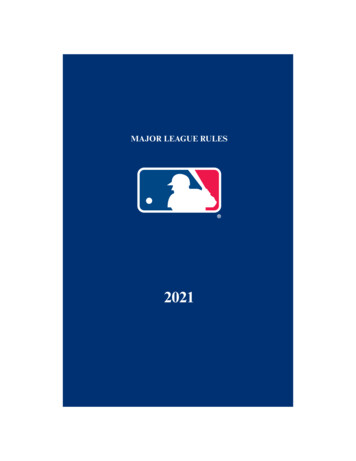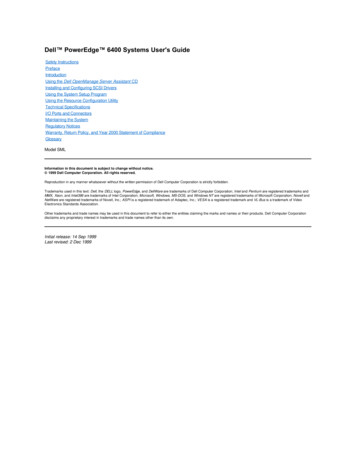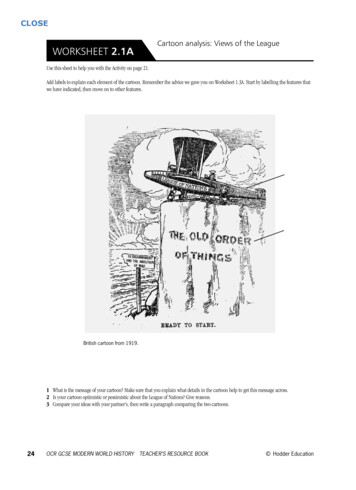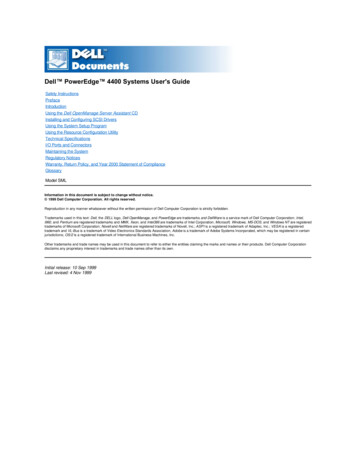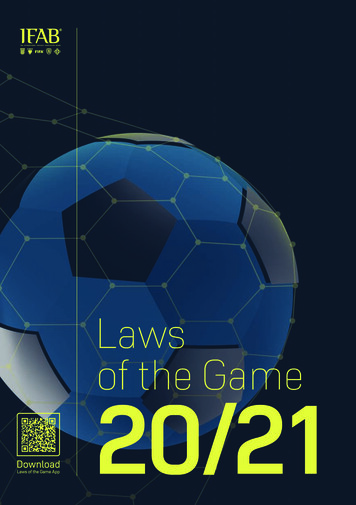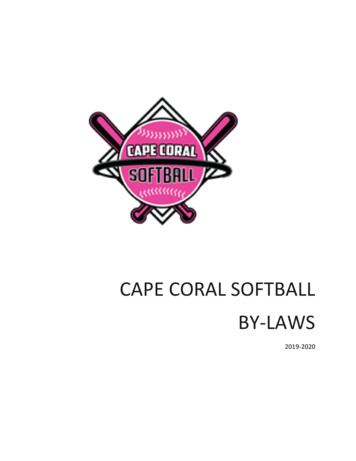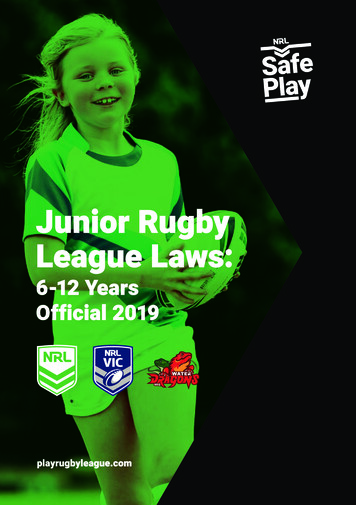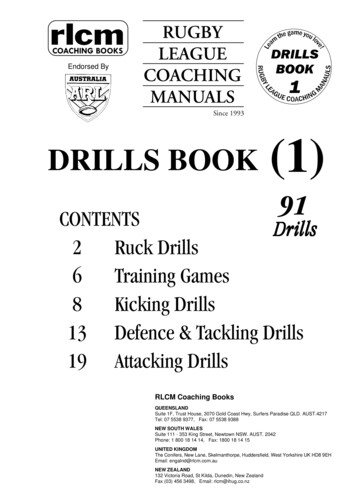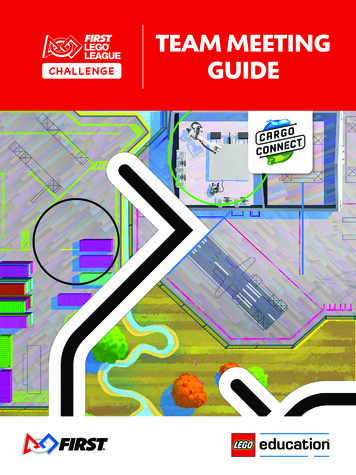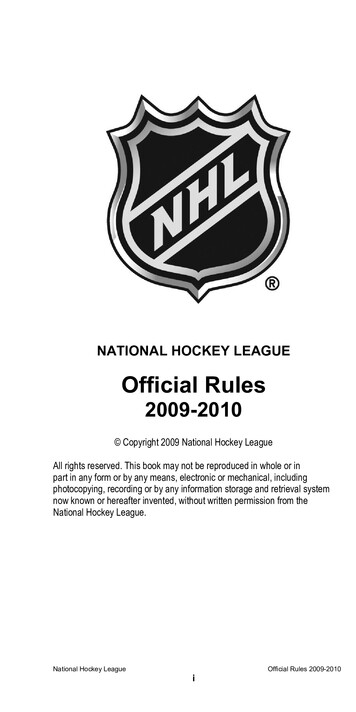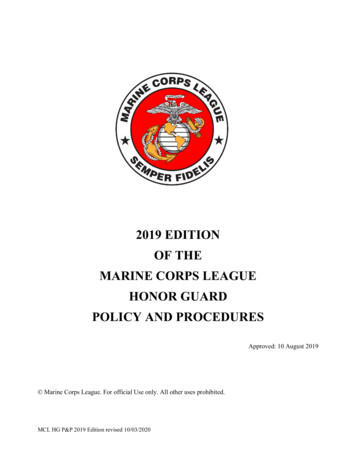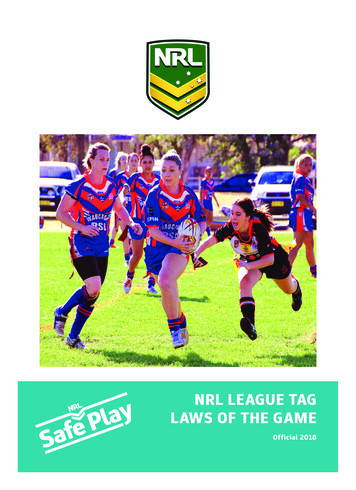
Transcription
NRL LEAGUE TAGLAWS OF THE GAMEOfficial 2018
Rugby League’s ValuesExcellenceInclusiveness» Valuing the importance of every» Engaging and empowering everyone» Striving to improve and innovate» Reaching out to new participants and» Setting clear goals against which» Promoting equality of opportunity in» Inspiring the highest standards in» Respecting and celebrating diversity inCourageTeamwork» Standing up for our beliefs and» Encouraging and supporting others» Being prepared to make a» Committing to a culture of honesty» Putting the game ahead of» Motivating those around us to» Having the strength to make the» Respecting the contribution ofdecision and every actionin everything we dowe measure successourselves and othersempowering others to do the samedifference by leading changeindividual needsright decisions, placing fact aheadof emotionto feel welcome in our gamesupportersall its formsculture, gender and social backgroundto achieve common goalsand trustchallenge themselvesevery individualThe NRL acknowledges the contribution of those who have assisted with thepublication of the (initial) 2016, 2017 and 2018 League Tag Law Books: Willy Barnes Brad Levy (Chair) Deerne McGregor Pat Walsh Bev Adams Shailyn Williams Dean Whymark Kylie Hilder Damian Kennedy
INTERNATIONALLEAGUE TAG LAWS13 years and aboveThe Laws of the International Game of Rugby League shall apply inLeague Tag subject to modifications, where applicable.INTERNATIONAL LEAGUE TAG LAWS3
CONTENTS PAGE4SECTION 1PLAYING FIELD / FIELD OF PLAY 5SECTION 2THE BALL 6SECTION 3THE PLAYER/PLAYERS EQUIPMENT 6SECTION 4MODE OF PLAY 8SECTION 5SCORING/TRIES AND GOALS 8SECTION 6STARTS/RE-STARTS OF PLAY 10SECTION 7“TAGGING” 11SECTION 8PLAY-THE-BALL 13SECTION 9TOUCH AND TOUCH IN-GOAL 14SECTION 10PENALTY KICK 15SECTION 11OFFSIDE 17INTERNATIONAL LEAGUE TAG LAWS
The Laws of the International Game of Rugby League shall apply in League Tag subjectto modifications, where applicable.SECTION 1THE PLAYING FIELDPLAYING FIELDTouchin-goalTouch ingoal lineTOUCHTOUCHLINETouchin-goalTouch ingoal line8m100 HLINETOUCHFIELD-OF-PLAY68 metres4010mDEAD BALL LINE3010mGoal PostIN-GOALGOAL LINETouchin-goal2010m20m1010mGoal Post20 Metre Line10mHalfway LineGoal Post10m20 Metres20 Metre Line5.50mGOAL LINEIN-GOALDEAD BALL LINE20 MetresGoal Post 16m10m10Touchin-goalPlaying FieldThe area bounded by, but not including, the touch lines and deadball lines. (In-goal: 8m deep)Field of PlayThe area bounded by, but not including, the touch lines and goallines. (Overall dimensions: 100m long; 68m wide)NOTES:1.The Touch Lines are in Touch, the Touch in-Goal lines are Touch in-Goal, the GoalLines are in the In-Goal area and the Dead Ball Line is beyond In-Goal.2.Indicates a corner post (see Glossary) placed at the intersection of each goalline and touch line. A corner post is in touch in-goal. Touch Judges should at alltimes ensure that corner posts are correctly positioned.3.The goal posts are considered to extend indefinitely upwards. It is recommendedthat the bottom two metres of each upright be padded, shaped goal posts arepermissible provided the relevant dimensions are observed.INTERNATIONAL LEAGUE TAG LAWS5
4.For adult games the dimensions should be as near maximum as possible to thedimensions stipulated.5.The broken lines in the PLAN shall consist of marks or dots on the ground notmore than two metres apart. All transverse lines must be marked across the fullwidth of the field.6.Two unbroken red lines, 10cms in width, across the field and adjacent to thecurrent white lines which presently mark the 40m lines are to be used.7.Whilst the diagram above indicates an in-goal area of between 6 and 11 metres,the accepted “norm” for the in-goal area is 8 metres.SECTION 2THE BALLShapeThe game shall be played with an oval, air-inflated ball, the outer casing of which shallbe of a material approved by the National Rugby League.Nothing shall be used in its construction which might prove dangerous to the players.Size and WeightAn International size ball shall be used - the dimensions of which shall be those approvedby the National Rugby League.Ball deflatedThe Referee shall blow his/her whistle immediately he/she notices that the size andshape of the ball no longer comply with the Laws of the Game.SECTION 3THE PLAYER/PLAYERS’ EQUIPMENTThe game shall be played by two teams each consisting of not more than 11 playerson the field at any one time. The minimum number of players per team allowed on thefield at any one time in a match is 8. The match shall be terminated should a team’scurrent participants be reduced to less than 8 players.a)6Each team may utilise Interchange players during the course of a match providedthat the names of the Interchange players are made known to the Referee beforethe commencement of the match. Interchanges will only be affected after aINTERNATIONAL LEAGUE TAG LAWS
player has left the field. The replacement takes the field immediately in an onsideposition with the permission of a Touch Judge/Interchange Official. Leaguegoverning bodies may choose to adopt either unlimited or limited Interchangerules for individual competitions.b)Each team shall use a maximum of 11 pairs of tags per game. If a player issubstituted during the game, the player leaving the field shall hand the tags tothe player entering the field.Each team will have a set of NRL sanctioned tags of distinctive colour whichare to be different to the opposing team. Tag length shall be no less than 34cmbut no greater than 36cm, and no less than 7cm and no greater than 8cm wide.Velcro tab attached to shorts shall be a maximum of 5cm x 5cm.c)A player shall not wear anything that might prove dangerous to other players.A player’s normal gear shall consist of a numbered jersey of distinctive colourand/or pattern, a pair of shorts with Velcro tabs attached, football socks ofdistinctive colour and/or pattern and studded boots or shoes.Skin tight shorts (bicycle shorts, Skins) are not permitted. Skins may be wornunder the shorts but must not have the Velcro tab attached. Belts are notpermitted. Jerseys must be tucked into shorts to ensure that the tags are notobstructed.Protective clothing may be worn provided it contains nothing of a rigid ordangerous nature. (No peaked caps or jewellery may be worn).Tags/Velcro/clothing may not be tampered with in any way.Any use of sprays, liquids, creams or similar – designed to make the hands ortags sticky – are strictly prohibited. Use of such materials will result in offendingplayers/teams not being permitted to take the field.The Referee shall order a player to remove any equipment which might beconsidered dangerous (or tampered with as per previous paragraph) and shallnot allow the player to take any further part in the game until the player hascomplied with this request. The player shall retire from the playing field toremove the offending item if the start or re-start of the game would otherwisebe delayed.d)When a player is bleeding excessively, the Referee shall direct him/her to eitherleave the field for attention or seek medical attention on-field.Note:Current participants are players on the field and players who have been temporarilysuspended (sin bin or blood bin). Dismissed players are not deemed as currentparticipants.INTERNATIONAL LEAGUE TAG LAWS7
Interchanges:A player other than a player who is replacing an injured player who has left the fieldcannot be interchanged during a play-the-ball except when play is stopped because ofinjury. If an interchange is affected when a kick at goal is to be taken, the interchangeplayer shall not be allowed to take the kick.Inspect EquipmentReferees should inspect players’ equipment before the start of the game or delegatethis duty to the Touch Judges. This does not relieve the player of the responsibility ofensuring that nothing of an offending nature is worn, nor rings, projecting metal onfootball boots, or long fingernails.SECTION 4MODE OF PLAYThe game is played over two 25 minute periods with a 5 minute interval between halves.League Governing bodies may set rules and regulations where time off for injury maybe played, and extra time may be used to determine a winner following a drawn matchat the completion of normal time (for Finals, where played, in International League Tagmatches only).The object of the game shall be to ground the ball in the opponents’ in-goal to scoretries and to kick the ball over the opponents’ cross bar to score goals.SECTION 5SCORING – TRIES AND GOALSA try shall count for 4 points.A successful conversion goal or a penalty goal shall count for 2 points. The conversionattempt shall be by place kick in line with where the try was scored.A drop goal during play shall count for 1 point.When scoring a try, two tags must be intact. If the ball is grounded with only one tag(unless the tag came off when the player made contact with the ground in the act ofscoring), it shall result in a “no try” (unless advantage applies, see below “late tag”)and play will be re-started with a play-the-ball to the attacking team 10 metres outfrom where the ball was grounded. The tag count shall continue unless after the 5thtag, which shall result in a handover, 10 metres out from where the ball was grounded.8INTERNATIONAL LEAGUE TAG LAWS
In the event of a late tag (i.e. where a tag has been removed, whether intentional or not,after the ball has been passed or kicked) the advantage rule should apply. The Refereeshall indicate a “late tag” and award the try.The game shall be won by the team scoring the greater number of points. If both teamsscore an equal number of points, or if both teams fail to score, then the game shall bedrawn.A try is scored when a player first grounds the ball in his/her opponent’s in-goal,provided that he/she is not in touch or touch in-goal, or on or over the dead ball line.NOTES:As soon as a tag has been removed from the ball-carrier, he/she must play-the-ball atthe point where he/she was tagged. A tagged player’s momentum cannot be used toprogress the ball into the opponents’ in-goal if a tag has been legally removed fromthe ball-carrier or if the ball-carrier is only carrying one tag (i.e. one tag has fallen offor has not been replaced correctly).Diving to scoreA player may only dive through a gap in a defensive line (not directly at players, whichmay cause a collision). The defender must have an opportunity to remove a tag.Attacking players cannot drop to their knees and reach through to attempt to score a try.Tagged in-goal before groundingIf the ball-carrier is tagged while in the opponent’s in-goal before being able to groundthe ball, play is re-started with a play-the-ball 10 metres out from the point at whichhe/she was tagged unless it is the 6th tag (this is similar to being “held-up” in-goal inthe International Laws of Rugby League), at which time a handover will occur 10 metresout from the goal line and no closer than 10 metres from the touch line.Ball on goal lineAs the goal lines themselves are in-goal, a try can be scored by an attacking playergrounding the ball on the goal line.NOTE: DECIDING WINNERSRefer to International LawsLeague Governing bodies should set rules and regulations where extra time is requiredto determine a winner following a drawn match at the completion of normal time. Acoin toss will take place prior to the commencement of extra time.INTERNATIONAL LEAGUE TAG LAWS9
SECTION 6STARTS/RE-STARTS OF PLAYStart of PlayThe kick-off is a place kick from the centre of the halfway line which commences thematch and recommences the match following half time and after points have beenscored.The game shall recommence with a handover to the kicking team should the ball findtouch other than on the full and having travelled the required distance of 10 metres.The handover shall take place 10 metres in opposite where the ball first crossed thetouch line.A penalty is awarded to the non-kicking team at the centre of the halfway line if theball is kicked out on the full.20 metre Re-startThe game is re-started with an optional kick from the centre of the 20m line if:a)an attacking player last touches the ball before it goes out of play over the deadball line or into touch in-goal except from a penalty kick (see Law 3), or from akick off from the centre of the halfway line;b)If the ball goes dead in the opponents’ in-goal from an unsuccessful penaltykick (not necessarily a kick at goal) the game is re-started with a drop-out by adefending player from the centre of the 20m line;c)A defending player catches the ball on the full from a kick in general play in his/her own in-goal.Goal Line Re-startThe game is re-started with a drop-out by a defending player from the centre of his/her goal line if:a)A defending player last touches the ball before it goes over the dead ball line orinto touch in-goal;b)A defending player accidentally infringes in the in-goal area;c)A defending player touches down in the in-goal area;d)A defending player in possession is tagged in the in-goal area;e)A defending player kicks the ball into touch on the full from his/her own in-goal;10INTERNATIONAL LEAGUE TAG LAWS
f)A defending player kicks or passes the ball in his/her own in-goal and the ballaccidentally strikes an opponent and goes into touch in-goal or over the deadball line;g)The ball or a defending player carrying the ball touches the Referee, a touch judgeor an encroaching spectator in the in-goal area and play is thereby irregularlyaffected;h)The ball goes over the dead ball line or into touch in-goal other than on the fullfrom a kick off from the centre of the halfway line.Penalties:A penalty kick resulting from an offence at the kick off shall be taken from the centreof the halfway line.Any penalty kick arising from the re-starting of play from the 20 metre line shall betaken from the centre of that line.A penalty kick resulting from any offence at the drop-out from between the posts shallbe taken from the centre of the line drawn parallel to, and 10 metres from, the goal line.A player shall be penalised if he/she:a)Wilfully touches the ball from a kick off or drop-out before it has travelled 10metres forward in the field of play;b)Runs in front of one of his/her own team who is kicking off or dropping-out;c)Approaches nearer than 10 metres to the line from which the kick is being takenwhen an opponent is kicking off or dropping-out.SECTION 7“TAGGING”A team in possession shall have a maximum of six (6) “tags”.A player in possession may be tagged by an opposing player or players. It is illegal totag or obstruct a player who is not in possession of the ball.A defending player cannot make a “tag” unless both of their tags are attached.The player in possession cannot fend off defenders or protect the tag by using thearm or ball to fend.The player in possession cannot jump through/at the defensive line to avoid being“tagged”.INTERNATIONAL LEAGUE TAG LAWS11
The player in possession cannot run directly at a defender and should be penalisedif a collision occurs in this situation. Refer section 10 penalty kick deliberate contactA player in possession cannot perform a 360 degree turn through/at the defensiveline to avoid being tagged, and will be penalised if he/she offends.Infringements also occur for obstruction and tagging without both tags attached.A Player in possession is tagged when:a)at least one of the tags is removed by an opposing player;b)a tag is accidently removed by the player in possession (or when the tag accidentlyfalls off the player).A player in possession shall not play-the-ball before being tagged.It is illegal for a player in possession to surrender prior to being tagged.If a player drops on a loose ball, he/she shall not remain on the ground waiting to betagged if he/she has time to regain their feet and continue play.Sixth TagA team in possession of the ball shall be allowed five successive play-the-balls. Ahandover shall occur AFTER the 5th play-the-ball in the following circumstances:a)The team is tagged a sixth time; the handover will occur at the point of the 6thtag. The play-the-ball for this purpose shall not be counted for the purposes ofthe tag count.b)The team in possession commits an accidental breach for which a change ofpossession to the non-offending side occurs;c)A player is tagged in the opponent’s in-goal; the changeover will occur 10 metresout from goal line.Accidental BreachWhere an accidental breach occurs (i.e. knock- on, forward pass) and possession changeshands, the following tag will be a “zero tag”, notwithstanding that the team gainingpossession may have gained a territorial advantage.Losing PossessionA tagged player shall not intentionally part with the ball other than by bringing itinto play in the prescribed manner. If, after being tagged, he/she accidentally losespossession, a handover will occur.12INTERNATIONAL LEAGUE TAG LAWS
Simultaneous TagIf the Referee calls ‘tagged’ and a player simultaneously continues to run or offloads,as he/she has not heard the call, the Referee will stop play and send the player backto the play-the-ball.Late TagWhere a tag has been intentionally removed, after the ball has been passed or kicked, apenalty to the non-offending team shall be awarded (unless the Advantage Law applies).Mid-air TagIt is illegal to tag an opposing player attempting to field a kick whilst the player is inmid-air. The catcher must have returned to the ground before being tagged.This Law applies only when a player on the non-kicking team catches the ball on the full.Indicating Last TagThe Referee shall indicate the 5th tag by raising one arm vertically with fingers andthumb out-stretched as per the International Laws process.Reaching / StrippingThe player at marker cannot reach around the body to obtain a tag.There is no “Stripping” or stealing the ball in any situation.SECTION 8PLAY-THE-BALLThe play-the-ball shall operate as follows:As soon as a tag has been removed from the ball-carrier he/she must play-the-ball atthe point where the tag occurred. There is no requirement for the ball-carrier to replacehis/her tag until the play-the-ball has been completed. Both tags must be in place forthis player to take any further active part in play.The tagged player shall face his/her opponent’s goal line and place the ball on theground in front of his/her foremost foot (in accordance with the International Laws)to play-the-ball.INTERNATIONAL LEAGUE TAG LAWS13
Players MarkingA maximum of two markers may take up the marking position (as per the InternationalLaws); they must be directly in front of the tagged player, and must remain in thatposition until the ball is played.The marker cannot play at the ball, nor reach around to affect a tag on the Acting Half.It is not mandatory for a marker to be present at the play-the-ball.Retire at Play-the-BallWith the exception of the marker, the defensive line must retire 10 metres (for 13 and14 years 5 metres) at the play-the-ball. The team in possession must retire behind theirplayers taking part in the play-the-ball.SECTION 9TOUCH AND TOUCH IN-GOALBall in touchThe ball is in touch when it, or a player in contact with it, touches the touch line or theground beyond the touch line or any object on or outside the touch in-goal line exceptwhen a player has been tagged in the field of play, and, on rising, steps into touch as he/she regains his/her feet, in which case that player shall play-the-ball in the field of play.Jumping playerThe ball is in touch if a player jumps from touch and knocks the ball back while off theground. The ball is not in touch if during flight it crosses the touch line but is knockedback by a player who is off the ground after jumping from the field of play.Touch in-goalThe ball is touch in-goal when it touches the corner post, in-goal line, or any object on,or outside, the touch in-goal line, however, if a player whilst in possession touches thecorner post, it will not be deemed as touch-in-goal.Points of EntryWhen a ball has entered touch or touch in-goal, the point of entry shall be taken as thepoint at which the ball first crossed the touch or touch in-goal line.If the ball is kicked by a player or is kicked and bounces off a player in a forward direction(except from in-goal) and it goes into touch on the full, a play-the-ball will occur wherecontact with the ball was made (but not nearer than ten 10 metres from the touch lineor ten 10 metres from the goal line).If the ball is kicked into touch from a penalty kick, the game is re-started by a free kick10 metres in-field opposite the point of entry into touch.14INTERNATIONAL LEAGUE TAG LAWS
SECTION 10PENALTY KICKThe International Laws of Rugby League will apply. Further penalties may be awardedfor conduct unbecoming on the field, such as: Avoidable contact Yes/No call Protecting tags Fending off defenders Late Tag Deliberate contact NOTE: The instigator of the contact shall bepenalized Deliberate grabbing of clothing 360º turn through the line Jumping through tagThe Sin Bin applies in League Tag and is of 10 minutes’ duration and may be applied for: Deliberately and continuously breaks the Laws of the game Uses offensive language Disputes the decision of the Referee Deliberately obstructs an opponent who is not in possessionA penalty kick shall be awarded against any player who is guilty of misconduct (Referto International Laws, Section 15) provided that this is not to the disadvantage of thenon-offending team. Unless otherwise stated, the mark is where the offence occurs.For Referee signals, refer to Pg 40.How TakenA player may take a penalty kick by punting, drop kicking, or place kicking the ball fromany point on or behind the mark and equidistant from the touch line.Other than when kicking for goal (“Pretending to kick at goal”) the ball may be kickedin any direction, after which it is in play.Players of the kicker’s team must be behind the ball when it is kicked.Players of the team opposing the kicker shall retire to their own goal line or 10 metresor more from the mark towards their own goal line and shall not make any attempt tointerfere with or distract the attention of the kicker.Find Toucha)If the ball is kicked into touch from a Penalty Kick without touching any otherplayer, the kicking team shall re-start play with a free kick. Opposing playersINTERNATIONAL LEAGUE TAG LAWS15
shall retire 10 metres from the point of entry into touch or to In the event of abreach by the opposing team a penalty kick shall be awarded at a point oppositewhere the breach occurred on a line parallel to the goal line 10 metres fromwhere the free kick was awarded;b)If the ball touches an opponent in flight and then enters touch, a change ofpossession to the non-offending side 10 metres in-field from where the ballcrossed the touch line. (Play-the-ball);c)Where a player kicks the ball in general play from any point in the area bounded byhis\her own dead ball line, 40 metre line and the touch lines and the ball finds touch,otherwise than on the full, at a point on the touchline between the opponents’ 20metre line and goal line, the kicker’s team shall be deemed to be the non-offendingteam. A tap kick is awarded to the kicking team 20 metres in from where the ballcrossed the touch line and no closer than ten 10 metres to the goal line.Free KickThe ball may be kicked in any direction in any manner when bringing it into play afterentering touch and the kicker may pick up the ball after he/she has kicked it (tap kick).Dead Ball from Penalty KickPlay is re-started with a 20m drop-out if the ball is kicked dead in the opponents’ ingoal from a penalty kick.If a penalty is awarded for an offence by the attacking team in the opponent’s in-goalarea, the mark shall be 10 metres in the field of play opposite where the offenceoccurred. For an offence in-goal by the defending team which incurs a penalty, themark is in the field of play 10 metres from the goal line and opposite where the offenceoccurred except for foul play against a try scorer.If a player fouls an opponent who is touching down for a try, a penalty kick at goal shallbe taken from in front of the goal posts after the attempt to convert the try. After his/her kick has been taken the ball shall be deemed dead and play shall be re-started fromthe halfway line. This law applies to the period during which the ball is touched downfor a try and not to any subsequent period (Possible 8 Point Try).16INTERNATIONAL LEAGUE TAG LAWS
Drop GoalIf a player fouls an opponent who is attempting a drop goal, a penalty kick shall beawarded in front of the goal posts.If the attempt at drop goal is successful, a kick at goal must be taken from the penaltykick and play re-started from the centre of the halfway line irrespective of the outcomeof that kick.If the attempt at drop goal is unsuccessful, the penalty kick can be taken in any mannerprovided for in the Laws and play re-started according to the outcome of that kick.SECTION 11OFFSIDEA player is offside except when he/she is in his/her own in-goal if the ball touches, istouched, held or kicked, by one of his own team behind him.An offside player shall not take any part in the game or attempt in any way to influencethe course of the game. He/she shall not encroach within 10 metres of an opponentwho is waiting for the ball and shall retire 10 metres immediately from any opponentwho first secures possession of the ball.Placed onsideAn offside player is placed onside if:a) An opponent moves 10 metres or more with the ball;b) An opponent touches the ball without retaining it;c) One of his/her own team in possession of the ball runs in front of him/her;d) One of his/her own team kicks the ball forward and takes up a position in front ofhim/her in the field of play;e) he/she retires behind the point where the ball was last touched by one of his/herown team.“Down Town”Any player who is in front of the kicker in general play is not permitted to advancebeyond the point of the previous play-the-ball until the ball has gone past the offsideplayers. This rule delays the movement of the offside players downfield in an attemptto encircle the ball receiver as he/she collects the ball.INTERNATIONAL LEAGUE TAG LAWS17
LEAGUETAG LAWS10 to 12 yearsThe Laws of the International Game of League Tag shall apply in10 12 Year LEAGUE TAG Game Modelsubject to the following modifications, where applicable.1810 - 12 LEAGUE TAG LAWS
CONTENTS PAGESECTION 1PLAYING FIELD / FIELD OF PLAY 20SECTION 2THE BALL 21SECTION 3THE PLAYER/PLAYERS EQUIPMENT 21SECTION 4MODE OF PLAY 22SECTION 5SCORING/TRIES AND GOALS 22SECTION 6STARTS/RE-STARTS OF PLAY 23SECTION 7“TAGGING” 23SECTION 8PLAY-THE-BALL 2410 - 12 LEAGUE TAG LAWS19
SECTION 1KICKINGTHE PLAYING FIELD10 - 12 YEARS IN-GOAL10 - 12 YEARS IN-GOAL2010 – 12 LEAGUE TAG LAWS
10, 11 and 12 YEARSOVERALL DIMENSIONS:80 metres long; 48 metres wide.Boundaries are the lines 10 metres from International Laws touch lines and goal lines.HALFWAY: is the halfway of the International Laws field.QUARTERWAY (1/4 WAY): is the 30 metre line of the International field.IN-GOAL: is that area between the International Laws goal line and the line10 metresfrom, and in front of, it. The touch in-goal lines are the portions of the two lines 10 metresfrom the International Laws field’s touch lines. Goalposts are part of the dead ball line.N.B. If markers or witches’ hats are to be used to outline the 10 – 12 Years field thenthey are to be placed in positions where they represent NO RISK to the health and wellbeing of the player - e.g. a metre or two from the actual playing area.SECTION 2THE BALLA size 4 ball is to be used in all 10 – 12 Year league TAG matches.SECTION 3THE PLAYER/PLAYERS’ EQUIPMENTMaximum number of players per team on the field at any one time is 8 (minimum 6),and only a maximum of 8 sets of tags are permitted.Should less than the minimum number of players be present then, for safety reasons,the match should be forfeited.An unlimited interchange Law will apply. All reserves present are to play either byinterchange or replacement.10 – 12 LEAGUE TAG LAWS21
SECTION 4MODE OF PLAYThe game is played over two 20 minute periods with a 3 minute interval between halves.League Governing bodies may set rules and regulations where time off for injury maybe played, and extra time may be used to determine a winner following a drawn matchat the completion of normal time (for Finals, where played, in nominated Mod LeagueTag matches only).The game is one of six (6) tag phases/periods. “Tags” are affected by removing a tagfrom a player. This is also known as “making a tag”. Once tagged, the player mustplay-the-ball. After a player has been tagged a sixth time; a changeover occurs to theopposition and the game recommences play with play-the-ball at the mark of the tag.The defensive line is to be of 5 metres from the ruck.SECTION 5SCORING – TRIES AND GOALSTries will be worth 4 points. A successful conversion shall count for 2 points.A goal may be attempted ONLY after a try has been scored.The attempt may be taken by either place kick or drop kick. Once a player has attempteda kick at goal (whether successful or not), that player may not attempt another until allothers of the same team (on the field at the time) have been given an attempt at a goal.This also applies at the awarding of an additional kick at goal following the awardingof a try when the try-scorer has been fouled in the act of scoring the try.Note: In the event that a player, who has already attempted a kick at goal, attemptsanother kick at goal, prior to all other players (on the field at the time) being given achance to kick, the points will not be awarded, if successful, and another attempt willnot be provided to the team to convert that try.Goalposts are those of the International Laws field. Method for use is outlined inApp
Teamwork » Encouraging and supporting others to achieve common goals » Committing to a culture of honesty . SECTION 11 OFFSIDE 17 INTERNATIONAL LEAGUE TAG LAWS. 5 The Laws of the International Game of Rugby League shall apply in League Tag subject to modifications, where applicable. SECTION 1 THE PLAYING FIELD 2 0 a M e t r e L i n e H l f .
